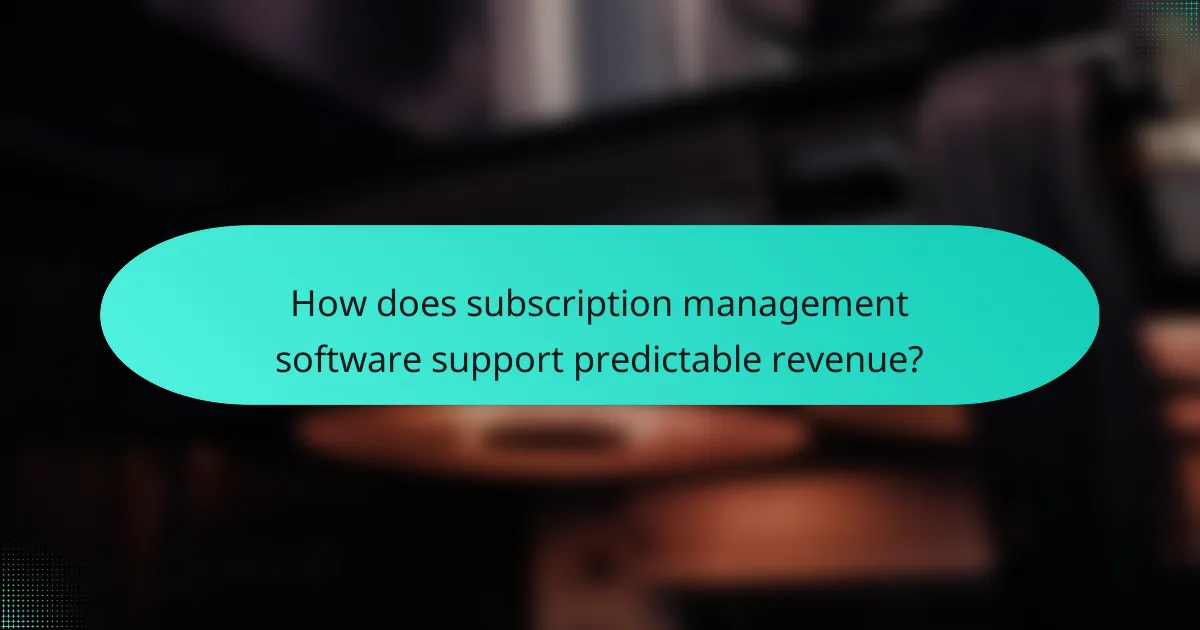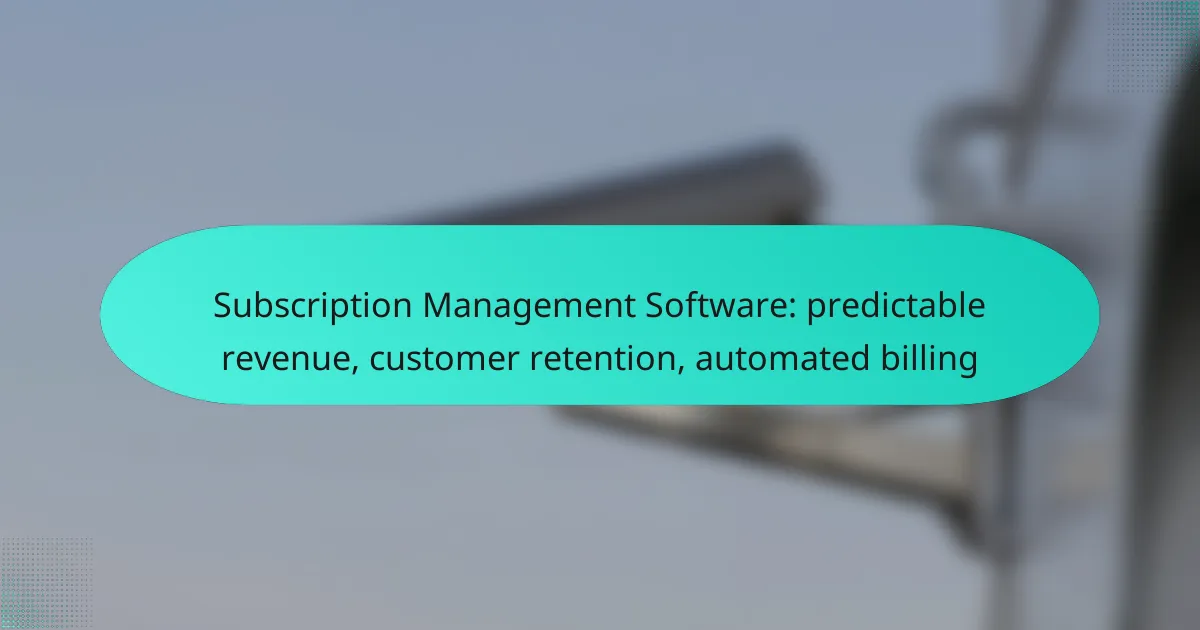Subscription management software plays a crucial role in enhancing predictable revenue, improving customer retention, and automating billing processes for businesses. By streamlining operations and personalizing customer interactions, these platforms foster stronger relationships with subscribers, ultimately leading to increased loyalty and reduced churn. With features like automated billing and analytics, companies can efficiently manage their subscriptions and accurately forecast revenue.

What are the best subscription management software options in Canada?
In Canada, several subscription management software options stand out for their ability to enhance predictable revenue, improve customer retention, and automate billing processes. These platforms cater to various business needs, offering features that streamline subscription management and billing operations.
Chargebee
Chargebee is a robust subscription management solution that supports businesses in automating billing, invoicing, and revenue recognition. It offers a range of features, including customizable pricing models and integration with various payment gateways, which can help Canadian businesses manage their subscriptions effectively.
With Chargebee, companies can easily handle complex billing scenarios, such as usage-based pricing or tiered plans. This flexibility allows businesses to adapt their offerings to meet customer demands, ultimately enhancing customer retention.
Recurly
Recurly provides a comprehensive subscription management platform that focuses on maximizing revenue through intelligent billing and analytics. Its features include dunning management, which helps recover failed payments, and advanced reporting tools that provide insights into customer behavior.
Canadian businesses can benefit from Recurly’s ability to support multiple currencies and payment methods, making it easier to cater to a diverse customer base. The platform’s user-friendly interface simplifies the subscription management process, allowing teams to focus on growth.
Zuora
Zuora is designed for larger enterprises that require a sophisticated subscription management system. It offers extensive features for billing, revenue recognition, and subscription analytics, making it suitable for businesses with complex subscription models.
For Canadian companies, Zuora’s ability to handle multi-currency transactions and compliance with local regulations is a significant advantage. However, its complexity may require a steeper learning curve and more resources for implementation compared to simpler solutions.
Stripe Billing
Stripe Billing is part of the broader Stripe payments ecosystem, offering a straightforward way to manage subscriptions and recurring payments. It integrates seamlessly with other Stripe services, providing a cohesive experience for businesses already using Stripe for payment processing.
Canadian businesses can leverage Stripe Billing’s flexible pricing options and automated invoicing features to enhance cash flow and customer satisfaction. Its developer-friendly API allows for easy customization, making it a popular choice among tech-savvy companies.
FreshBooks
FreshBooks is primarily known as an accounting software but also offers subscription management capabilities. It is ideal for small to medium-sized businesses looking for an all-in-one solution that includes invoicing, expense tracking, and time management.
For Canadian entrepreneurs, FreshBooks provides a user-friendly interface and essential features for managing recurring billing. Its ability to generate reports and track payments helps businesses maintain a clear overview of their financial health, supporting better decision-making.

How does subscription management software improve customer retention?
Subscription management software enhances customer retention by streamlining interactions and personalizing experiences. By automating processes and utilizing data, businesses can foster stronger relationships with their subscribers, leading to increased loyalty and reduced churn.
Automated communication
Automated communication tools within subscription management software facilitate timely and relevant interactions with customers. This includes sending reminders for renewals, updates on billing, and notifications about new features or promotions. Consistent communication helps keep customers informed and engaged, reducing the likelihood of cancellations.
For example, a SaaS company might set up automated emails to remind users of their upcoming subscription renewal a week in advance, allowing them to make any necessary changes without feeling rushed.
Personalized experiences
Personalization is key to enhancing customer retention, and subscription management software can tailor experiences based on user behavior and preferences. By analyzing data, businesses can offer customized recommendations, discounts, or content that resonates with individual subscribers.
For instance, a streaming service might use viewing history to suggest new shows or movies, making users feel valued and understood. This tailored approach encourages continued engagement and loyalty.
Data-driven insights
Data-driven insights from subscription management software provide valuable information about customer behavior and preferences. By tracking metrics such as churn rates, engagement levels, and payment histories, businesses can identify trends and make informed decisions to enhance retention strategies.
Regularly reviewing these insights allows companies to adjust their offerings, improve customer service, and address potential issues before they lead to cancellations. For example, if data shows a spike in churn after a price increase, a business might consider offering a loyalty discount to retain those customers.

What are the key features of subscription management software?
Subscription management software typically includes automated billing, analytics, flexible pricing models, and integration capabilities. These features help businesses streamline their operations, enhance customer retention, and predict revenue more accurately.
Automated billing
Automated billing simplifies the payment process by automatically charging customers at predefined intervals. This feature reduces administrative workload and minimizes human error, ensuring timely payments and consistent cash flow.
Businesses can set up various billing cycles, such as monthly, quarterly, or annually, and offer multiple payment methods like credit cards, ACH transfers, or digital wallets. This flexibility can cater to diverse customer preferences, improving overall satisfaction.
Analytics and reporting
Analytics and reporting tools provide insights into customer behavior, revenue trends, and churn rates. These metrics are crucial for understanding how well a subscription model is performing and identifying areas for improvement.
Subscription management software often includes dashboards that visualize key performance indicators (KPIs), allowing businesses to make data-driven decisions. Regularly reviewing these reports can help optimize pricing strategies and enhance customer retention efforts.
Flexible pricing models
Flexible pricing models allow businesses to tailor their offerings based on customer needs and market conditions. Options may include tiered pricing, usage-based billing, or promotional discounts, which can attract a wider range of customers.
Implementing various pricing strategies can increase revenue potential and reduce churn. For example, offering a free trial or a discounted introductory rate can entice new subscribers to try the service before committing to a full-priced plan.
Integration capabilities
Integration capabilities enable subscription management software to work seamlessly with other business systems, such as CRM, accounting, and marketing platforms. This connectivity ensures that data flows smoothly across departments, enhancing operational efficiency.
Choosing software that integrates well with existing tools can save time and reduce the risk of data silos. Look for solutions that offer APIs or pre-built connectors to popular applications, facilitating a more cohesive business ecosystem.

How does subscription management software support predictable revenue?
Subscription management software enhances predictable revenue by automating billing processes, providing insights into customer behavior, and enabling accurate forecasting. This technology helps businesses maintain steady cash flow and improve financial planning.
Recurring billing cycles
Recurring billing cycles are fundamental to subscription management, allowing businesses to charge customers at regular intervals, such as monthly or annually. This consistency helps create a reliable revenue stream, making it easier to predict income over time.
When setting up billing cycles, consider offering flexible options to accommodate different customer preferences. For instance, some customers may prefer monthly payments, while others might opt for annual subscriptions at a discounted rate.
Revenue forecasting tools
Revenue forecasting tools within subscription management software analyze historical data to project future income. These tools often use metrics like average revenue per user (ARPU) and customer lifetime value (CLV) to provide insights into potential earnings.
Utilizing these forecasting tools can help businesses make informed decisions about pricing strategies and resource allocation. Regularly updating forecasts based on new data can improve accuracy and support better financial planning.
Churn rate analysis
Churn rate analysis is essential for understanding customer retention and its impact on predictable revenue. By tracking the percentage of customers who cancel their subscriptions, businesses can identify trends and areas for improvement.
To effectively analyze churn, consider segmenting customers based on their behaviors or demographics. This approach allows for targeted strategies to reduce churn, such as personalized communication or tailored offers, ultimately enhancing customer loyalty and revenue stability.

What criteria should you consider when selecting subscription management software?
When selecting subscription management software, focus on scalability, ease of integration, customer support, and compliance with relevant regulations. These criteria ensure that the software can grow with your business, streamline operations, and maintain customer satisfaction.
Scalability
Scalability refers to the software’s ability to handle increasing volumes of transactions and customers without performance issues. As your subscription business grows, you need a solution that can accommodate more users, products, and payment methods seamlessly.
Consider software that offers flexible pricing plans and can support various subscription models, such as tiered pricing or usage-based billing. This flexibility allows you to adapt to changing market demands and customer preferences.
Look for platforms that provide robust reporting and analytics tools. These features help you monitor growth trends and make informed decisions about scaling your offerings. A good rule of thumb is to choose software that can support at least double your current customer base to ensure future growth is manageable.
